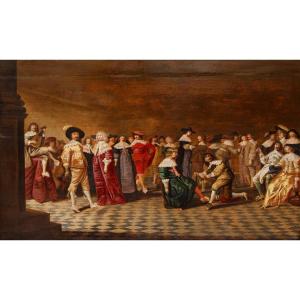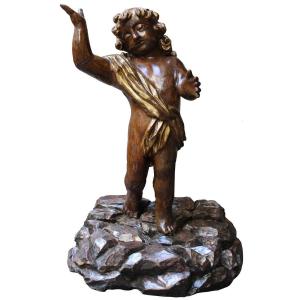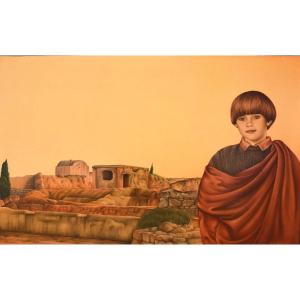Dance scene - the garter
Oil on oak board, cm 120 x 75
Monogrammed and dated bottom right: year 1639 J.W. (or I.W.)
Provenance: collection Spirlet, Liège before 1928 (as Antoine Palamedesz); collection Jules and Jean Lalière, Namur; Brussels, Vanderkindere, 16 octobre 2018, n°143.
Jan Jansz. Westerbaen I (c. 1600-1686) emerges from historical documentation as a figure well established in the social and artistic fabric of 17th century The Hague. Not only was he a prolific painter, but also an active and influential member of the institutions that regulated art in the city, testifying to a commitment that went far beyond mere artistic production. Born to Jan Jacobsz Westerbaen, a rope maker, Jan Jansz. Westerbaen I came from a family which already had several prominent figures in the cultural scene of its time. He was the younger brother of Jacob Westerbaen, a well-known author, and his family became further entwined with the art world through the marriage of his sister Anneke to the painter Salomon de Bray in 1625. These family links not only suggest a culturally stimulating environment, but also a network of contacts which may have helped his career. In 1630, Jan married the widow Maria Bartelmeesdr Suijster in The Hague, and from this union was born Jan Jansz. Westerbaen II, who will follow in his father’s footsteps and also become a painter. Westerbaen’s artistic training began early: in 1619 he is documented as an apprentice of Evert van der Maes. Five years later, in 1624, he entered fully into the Guild of Saint Luke, the corporate organization that regulated the profession of painters. His participation in the life of the guild was anything but passive;held the role of supervisor (warden) in the steering committee several times, with mandates in the years 1642-1643, 1644-1645 and 1650-1651. A crucial moment in his institutional career was the co-founding of the Confrerie Pictura in 1656. This brotherhood was created in a period of tensions and reforms within the Dutch guilds: it had the intention to raise the status of artists and provide them with greater protection. Westerbaen continued to hold supervisory roles also within the Confrerie Pictura, serving in 1659-60, 1660-61, 1663-64 and 1664-65. The last mention of Westerbaen in documents dates back to 1674, in connection with a case involving Pieter van der Hulst, suggesting his continued activity or influence even at an advanced age.The work depicts one of the most important moments of a dancing party attended by members of the aristocracy and the powerful Flemish merchant class, richly dressed and dedicated to the pleasures of life. At the center of the composition, a couple in the foreground captures the attention of the observer: a kneeling man, dressed in a green and gold dress, who seems to knot the garter of a sitting woman, Also beautifully dressed in a dark green dress with white inserts and a wide collar. On the left, a man with a feathered hat and a sumptuous gold and white dress stands with an expression of restraint or attention to the event, flanked by a woman dressed in an elegant dark red silk brocade dress with white trim. Further to the left, you can see other characters, including one who plays a musical instrument similar to a lute or a viola da gamba. Most of the figures wear wide white collars, often adorned, and different hats, depending on gender and social position. The scene, both at an iconographic level and under the technical-executive aspect, takes up the key statements of the works of the ideal master of Westerbaen, Antoine Palamedesz, known as Stevers (Leith, 1602 - Amsterdam, 1673), a painter known for his interior scenes and for his gallant celebrations rich in characters rendered through the lenticular of Flemish art. From the works of Palamedesz are taken almost literally, in our painting, some characters. Westerbaen is usually a portrait painter with half-pipe: among his best known paintings are two female portraits, one currently at the Rhode Island School of Design Museum and the other at the Rijksmuseum in Amsterdam, and the Portrait of Arnoldus Geesteranus (1593- 1658), among the masterpieces of the Mauritshuis in The Hague;It is also for this reason that our painting constitutes an absolute rarity. This is one of only two choral paintings by the Flemish painter: the other, which shares iconography, setting and technique with the one in question, published as Family Scene on the RKD is currently part of a private collection. The attribution to Westerbaen is also confirmed by the monogram I.W. affixed in the lower left section of the table: observing the portraits of the artist originally from The Hague, you can see how he used these methods to sign himself.


















































 Le Magazine de PROANTIC
Le Magazine de PROANTIC TRÉSORS Magazine
TRÉSORS Magazine Rivista Artiquariato
Rivista Artiquariato